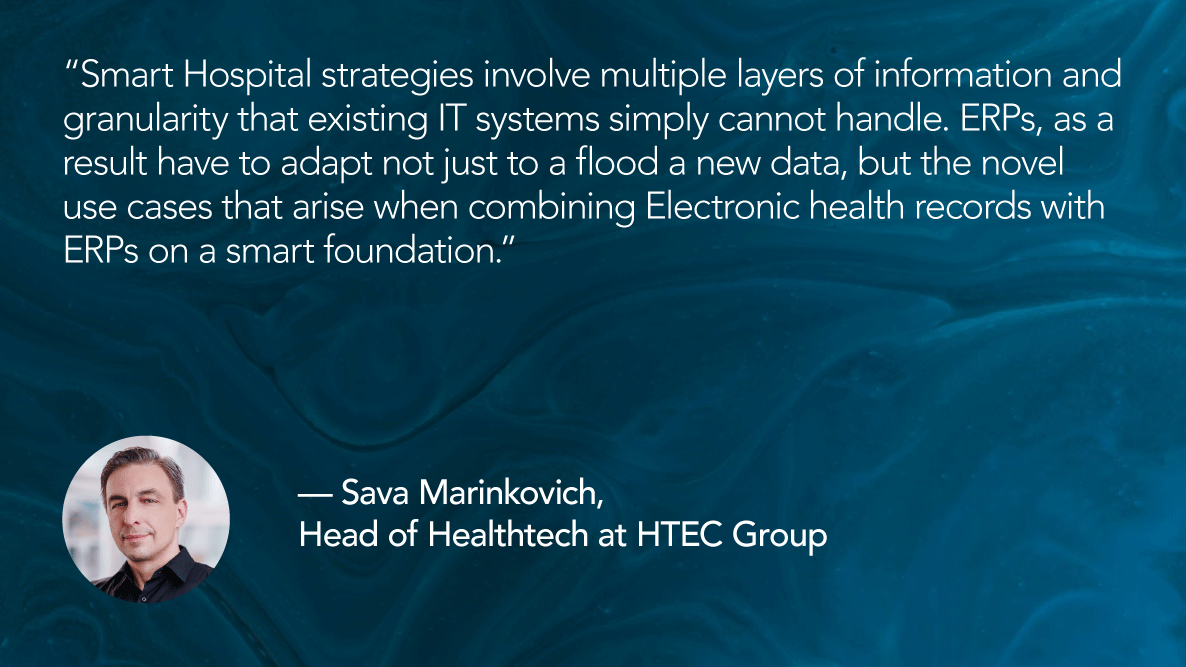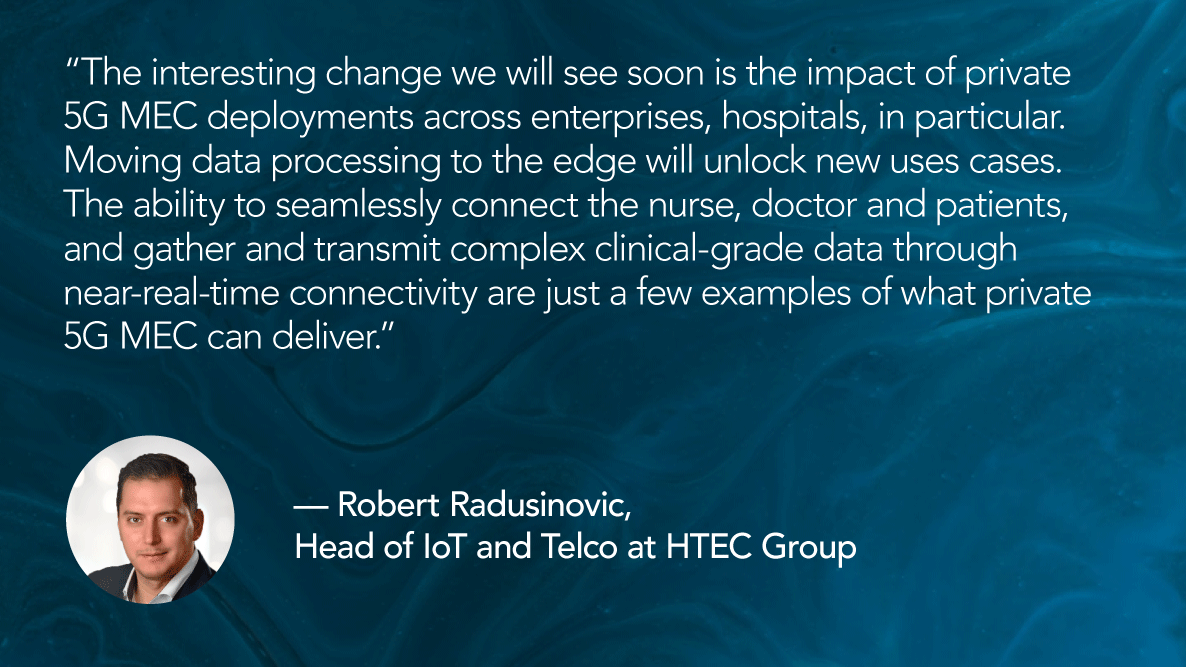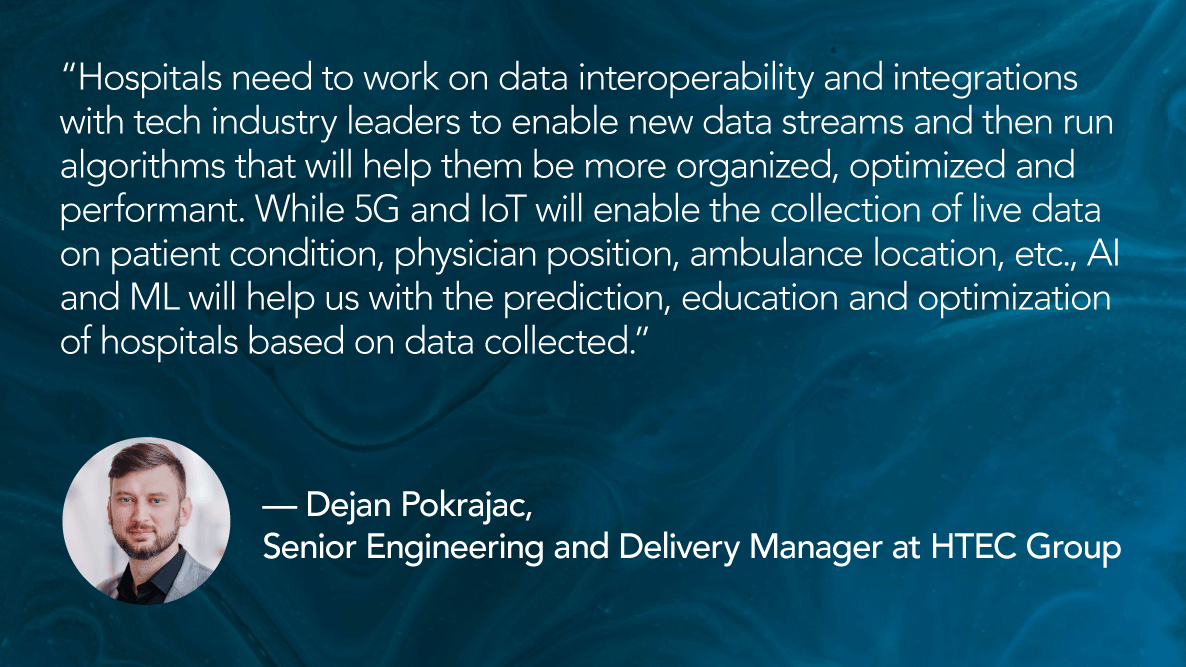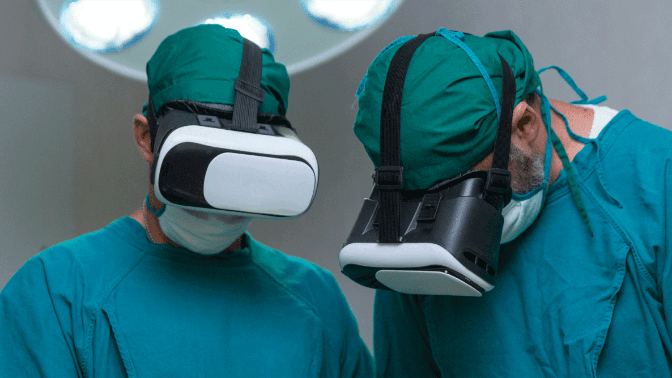More than 95% of hospitals possess an Electronic Health Record (EHR) system. However, EHRs have shown to be lacking in easing patient care, especially when they operate in the disjointed world of hospital logistics, personnel, and planning. The workflows, patient, staff, and practitioner realities don’t ease when you have patient data in one place. EHRs can even be a source of significant patient and practitioner risk when they start offering poorly thought-out initiatives like Sepsis detection.
What EHRs lack may be found in Enterprise Resource Planning (ERP) systems.
But what ERPs lack is a holistic view of patient-level data together with the operational view of how care delivery is managed.
Imagine two patient scenarios:
Scenario A (“The digital but non-holistic hospital”):
A patient comes to the hospital complaining about pain in their chest. The doctor prescribes a chest x-ray, ECG, and potentially other medical imaging. After receiving the images, the doctor directs the patient to an additional examination with a cardiologist. The cardiologist then prescribes a therapy based on the info his colleague provided without seeing the images or consulting and discussing the issue with the doctor in person. The result – miscommunication which may then lead to the wrong therapy.
(Operationally, there are added exchanges and effort by the doctors. The questions arise: Is this a better way to treat this type of chest pain situation? What has been the total cost and time view of the patient? Which devices were used? Are the right devices being used?)
Scenario B (“The fused-experience hospital”):
A patient comes to the hospital with chest pain. The doctor conducts a battery of relevant tests. All the data about patients, patient records, the history of illnesses, medicine they have used, etc., are accessible on a single platform, and everyone has easy access to it. The doctor easily finds the patient’s history of illness and visuals about past treatments. Images are automatically uploaded to the patient’s file, and both their doctor and cardiologist are able to view the images and decide on the best possible approach to determine the precise diagnosis and optimal patient care.
(Operationally, the hospital has insight into the time required to complete the patient’s treatment, use of devices over the course of the visit, and creates a holistic view of chest pain operational efficiency.)
Is the transition to next-gen ERP an imperative?
Over the past few years, only a few industries have experienced the same amount of pressure and collision of forces as HealthTech: the pandemic, ground-breaking advances in medical science, a revolution in digital technologies, significantly higher costs, staffing issues, and a growing need to protect patient data. Moreover, practitioners recognize that keeping a patient healthy through prevention is far better than disease care. Finally, in our digital work, medical institutions are searching for ways to work more efficiently while making sure their data stays secure from ransom and unintentional disclosure.
ERP systems offer a solution, but their true potential shines when they are integrated into the patient experience and patient data. Today, there are categories of patient medical conditions, e.g., cardiology, internal medicine, and others. Yet, these are not linked at the patient medical condition to what ERPs provide today.
Imagine you have ERP processes like staffing, financing returns, activity levels, and bottlenecks tied to more detailed medical information from the EHR. Are doctors efficiently allocated to their patients? Is there a time when a home patient can be better served in the hospital? When does it make sense? ERPs can be powerful forces of insight yet have fundamental challenges:
Critical challenges with ERPs
As companies manage the transition to the next-generation ERPs with digital solutions and cloud features, they must first address their business challenges and then prepare for a smooth transition of core ERP functionalities.
Four challenges remain to the generation of ERPs:
1. Limited integration and interoperability
In healthcare environments, ERPs must crucially interact with other systems inside and outside of the organization. However, these systems contain a vast number of ERP applications with limited integration and interoperability. On top of this, extracting business insights out of the data is a real pain. Finally, integrating new acquisitions is a rather complex procedure. All of this has caused companies to keep the status quo which further slowed down the adoption of the next-generation ERPs.
Robert Radusinovic, Head of IoT and Telco at HTEC, points out that the lack of interoperability is one of the biggest challenges medical companies face when trying to adopt ERPs: “The lack of existing integration between internal systems, that also includes ERP software, prevents data from being accessed and shared across multiple departments. The lift required to solve this is very complex, and it is a burden on internal engineering teams to execute on. This is the main challenge we are seeing with customers looking at these new solutions — they are troubled at how to use all that data within their ERP software and other systems that aren’t fully integrated. Therefore, this is where we see a need for custom product development that should help these companies speed up time to market.”
2. Aging digital infrastructures
Implementation of next-gen ERPs relies on having a strong digital infrastructure. Unfortunately, healthcare technology is not always updated regularly in many institutions, and most of it relies on traditional, outdated, legacy infrastructure. For instance, an IoT network is non-negotiable when undertaking healthcare digitization projects. To create a truly connected IoT ecosystem, older IoT sensors need to be able to sync with newer ones seamlessly.
Sava Marinkovich, Head of HealthTech at HTEC, explains: “There’s no doubt that Covid-19 has accelerated the migration from traditional ERPs to next-generation ones not only in hospitals but across industries. Now, hospitals want to know everything — from cost per patient to the history of patients’ diseases. However, hospital systems, like their supply chains, are still antiquated – it’s essential for institutions to be ahead of the curve. To be able to do that, they need to explore and introduce new bandwidth and connectivity that didn’t exist before.”
3. A fused experience
Decision-making in hospitals is still far behind that in retail and consumer industries. Any digital interface that is poorly constructed, adds to the mental burden of staff and users to interpret and decide how to proceed on a regular basis. Today’s staffing shortages and burnout, and poor fused information only accentuate these problems.
But, a well-designed experience, informed by rich data streams, presented in a simple and intuitive way, yet comprehensively, could aid practitioners and staff greatly in serving patients better. Understanding costs, activities within the hospital, and patient insights, without having to click through dozens of menus, will help make the work of healing patients more efficient.
4. Limited staff availability
Staff burnout, shortages, and mindshare prevent staff from serving patients but also having time to think through innovative ways to improve care within their own institutions. Staff are critical when it comes to incorporating new initiatives as they take ownership of the projects and share feedback, yet they cannot always be available because of the competing demands. More intuitive inputs and digital experiences will help staff contribute more and refine the way they deliver care.
ERP in hospitals: what’s next?
ERP systems will need to adapt to the new availability of data
Given that there are multiple layers of information in smart hospitals, ERPs will have to change and adapt to the new availability of the data. However, companies need to step back and consider what new opportunities this data can bring to them.
“There is this huge amount of information coming. With huge amounts of immersive data streaming through smart hospitals, ERPs will need to adjust to provide a far more granular visibility in the hospital. Now, there is unlimited bandwidth applied to many more components of the hospital, from the managing machines to the patient activities. But getting access to data is not enough. Once hospitals change technologies in their infrastructure, they need to know how to tie new data to new decisions that open up. It all comes down to enabling next-level business intelligence and better decision-making – these play key roles in not only access and care delivery but also superior patient experience”, says Sava Marinkovich, Head of Health at HTEC Group.

5G will bring the concept of connected hospitals from concept to reality
5G does two things — it provides unlimited bandwidth on small devices without using cables and it allows companies to create dynamic connections between devices that would, otherwise, be far more cumbersome. This allows companies to create a room that has its own self-governed 5G network that allows for far more rapid connectivity versus having to go through cable network.
“In the context of hospitals, 5G would enable easier and faster connection of MRI bed-side monitors and monitoring equipment, meaning they can put processing power at the ends of the network instead of going to the Cloud and back. This way, hospitals can get a network as a service without having to worry about cables and they can have local islands of information which allow edge computing. This provides hospital staff with enough data so that they can make smarter decisions about how to triage patients using the images from MRI and learn more about the patient and their needs to be able to be proactive in future.”, explains Sava.
The interesting change we will see in the near future is the impact of private 5G MEC deployments across enterprises, which is already happening. What does this mean for the healthcare providers and why do they care?
“We’ve been fortunate to be in these kinds of conversations with healthcare providers and network operators by helping them drive innovation and solve challenges they are facing today. Now that the hospitals can get their hands on private 5G MEC, the ability to move data processing to the edge will help them unlock new uses cases that will drive positive change in these environments. This is what really excites our customers. The ability to seamlessly connect the nurse, doctor and patients, and enable near-real-time connectivity to gather and transmit complex clinical-grade data is just one example of what private 5G MEC can deliver.”, explains Robert.
However, Robert also explains that enterprises are investing in custom product development due to a nascent eco-system of solution providers available today, but also keeping top of mind security risks and addressing these potential challenges early on.

Technology will create an integration layer between payers and providers
As mentioned above, one of the biggest challenges when improving ERP systems in hospitals is how to address the data interoperability issue.
Dejan Pokrajac, Senior Engineering and Delivery Manager, believes that in order to make better decisions, hospitals need to make their processes data-driven. They need to work on data interoperability and integrations with tech industry leaders to enable as many new data streams as possible and on top of data run algorithms that will help them be more organized, optimized and performant.
“Technology can create an integration layer between payers and providers that collect data — ML and AI will help in data manipulation and educate us with coaching nudges to optimize the whole back and forth process between payers and providers. On top of this, AI and ML will help with the prediction, education and optimization of hospitals based on data collected. Also, hospitals need to leverage 5G and IoT for live data collection to enable asset tracking, real-time monitoring of patient condition, physician position, ambulance location, etc. Finally, hospitals need to consider the speed of innovation when developing new home medical devices. They need to ensure the right data is collected on time so that they would be able to provide patients with as best care as possible.”, explains Dejan.

Having connected devices doesn’t equate to a successful or overarching strategy
ERP is set to evolve and change to fit the needs of users and their business goals. Tech leaders should keep an eye out for these trends as we continue to experience seismic shifts in the market. Healthcare organizations should look for implementation partners that will help them implement ERP systems in the most efficient way powered by the latest technologies and their deep domain expertise.
“What our clients expect is for us to help them improve internal business processes, reduce costs, and streamline operations so they can improve their decision-making and use invaluable insights to offer superior patient care,” says Robert.
What’s your next step? Connect with Sava Marinkovich, Robert Radusinovic and Dejan Pokrajac to learn how we can help you build connected hospital of the future.






